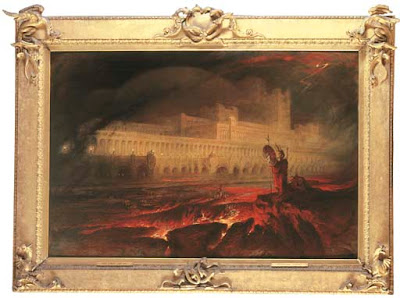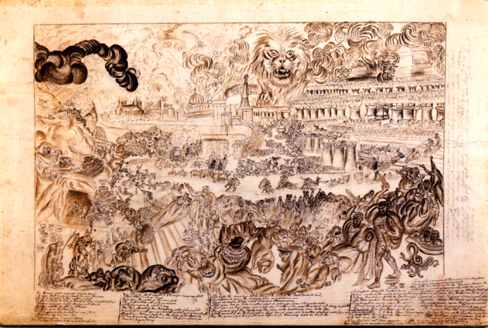Last week I discovered, much to my surprise and delight, that the Arnolfini in Bristol was staging an exhibition titled Superpower: Africa in Science Fiction. The Arnolfini is an arts centre in the Bristol docklands, situated opposite the Watershed which I’ve mentioned many times before. It is one of those “white room†exhibition spaces, but it also contains lecture rooms and I attended a talk by Tom Abba there earlier this year. The Africa exhibition opened on the Saturday, and there was a discussion panel involving the curators, Nav Haq and Al Cameron, and one of the exhibitors. I was there, as were Mark Bould, Tim Maughan and David Roden. You may have seen my tweets.
The exhibition is a mixture of work by Western artists who have visited Africa to make their work, and work by African artists. Personally I’d prefer to see the latter, but if you have an exhibition you need to fill then you take what you can get. I appreciate that the modern fashion is for very sparse exhibitions, but it did seem like there was room for more, so either the budget or the available material may have run out.
The importance of events such as this became very obvious during the panel discussion when we got on to talking about the idea of presenting positive futures for Africa, as compared to how African artists can make money. Suppose you are an African photographer. It would be nice to be able to sell your work to the Western media. To do that, you have to know what they want, and what they want is very simple: pictures of suffering. There’s no money to be made in Africa, we were told, by showing Africans as happy, healthy, self-reliant and successful people. What the Western media wants is pictures of Africa that play to the prevailing image of it as a failed continent: a place full over poverty, war, starvation.
Science fiction, then, gives us an opportunity to present a different Africa. Not Africa as it is defined to be by our media, but one which we claim to have made up, and can therefore be more real. Or not, depending on how much invention happens to take place. At any rate, there can be confidence, and hope.
The majority of the exhibits are short films. I want to return to this in a little while, but first I want to highlight some of the exhibits, and that fact that many of them are on film means that I haven’t had a chance to see the whole thing. I’ll be partly going from descriptions in the exhibition brochure, and partly from what I know of the material in question from other sources. First, however, a few things I can talk more authoritatively about.
The one item that is entirely text is a transcript of a round table discussion that took place on ARPANET in 1976. That’s remarkable enough, but the participants include American political economist, Francis Fukayama, and the South African activist, Steven Biko. That’s a conversation that it is fascinating to be able to step through time and listen in on.
Another exhibit that is easily and quickly viewed is Icarus 13, a series of photographs accompanied by a model and some text. The installation was created by Angolan artist, Kiluanji Kia Henda. He was supposed to be present at the panel discussion, but was unable to leave Angola. There was no explanation as to why, but I fear he may have been denied entry to the UK.
Icarus 13 is based on an Africa joke about a past President of Mozambique with big ideas. He is supposed to have decided that his country would launch a manned mission to the sun. On being told that the rocket would burn up in the sun’s heat he declared, “we will go at night!†So the joke is that the presidents of newly independent African countries have ideas way beyond their ability to deliver. Yet Henda had created a exhibit which shows photographs of the supposed sunship being built, and even the astronauts returning home. There’s a picture of the ship below, taken from the website of the research organization, Former West, and you can read the amusing description of the mission that Henda provided at this Spanish arts site. The “ship” is actually a real building in Luanda, the capital of Angola. It is the Agostinho Neto Mausoleum, a memorial to the country’s first president.

A second photographic exhibit is Common Task: Mali, by Paweł Althamer from Warsaw. He and his crew traveled to the lands of the Dogon and dressed in gold suits so that they could get pictures of “aliens†visiting Mali. The Dogon, of course, are one of the peoples whom Erich von Daniken claimed had been visited by extraterrestrials (The Sirius Mystery, debunk here). I can see what Althamer was trying to do, but without context the pictures just looked like a bunch of rich Westerners peering at the unfortunate savages, which I’m sure wasn’t the message I was supposed to take away.
On then, to the films. The first one I’d like to note is Neill Blomkamp’s Alive in Joburg. This is something he shot as a trailer for District 9. It features a number of real Johannesburg citizens complaining about the influx of immigrants to the city. In District 9 these immigrants are aliens, but Blomkamp got the footage by asking his subjects to talk about human immigrants from Zimbabwe.
Superpower – Dakar Chapter is a film by British artist, Mark Aerial Waller. He was present at the panel, and clearly knew a bit about science fiction — he kept citing Phil Dick. In the film, a group of Senagalese astronomers discover a gas cloud that acts as a mirror, reflecting light from Earth back home. In this way we are able to watch images from our own past. I’m not sure about the physics of this, but it reminded me of Robert Charles Wilson’s Blind Lake. It was a nice SFnal idea. Mark tells me that much of his work has SF themes. You can see more of what he does at his website.
Finally we have Pumzi, a film by Kenya’s Wanuri Kahiu. Nnedi Okorafor has been enthusing about this for time, and Gary Wolfe added his voice after she got him to see it. Peggy Kolm mentioned it too, and I blogged about it early in 2010. At last I am going to be able to see the whole thing myself. This is classic science fiction. (Tim, who has seen it, says it reminds him of films like Logan’s Run and THX-1138).
Overall I am very pleased that this exhibition exists. However, I do have some reservations about the nature of the content. Firstly, of course, films do not make good art gallery exhibits. How many visitors are going to wait for the next showing of Pumzi to start, and then sit through all 21 minutes of it? Not many, I suspect, so the material won’t be shown to best effect.
Of course I’m concerned about the lack of any literary material in the exhibit. I am, after all, a literary critic. And as I showed in my earlier post, there’s a lot of science fiction being written about Africa, and by Africans. Sadly it is difficult to get the British arts establishment to take literary SF seriously. Tell them you are doing work on science fiction films and they’ll be happy to support you. Tell them you are working on science fiction books and they’ll turn their noses up.
The problem with this, however, is that the emphasis on film immediately puts the Africans in a position of inferiority. Making a film is an expensive business requiring many people and complicated equipment. Science fiction films, in particular, are expected to include impressive special effects. Any film produced by Africans will inevitably be compared with the output of Hollywood and found wanting. Books, on the other hand, are comparatively easy to produce. All they require is a talented author with a computer and lots of time. Some African writers are already producing SF&F literature as good as, or better than, most Western writers can manage (for example NgÅ©gÄ© wa Thiong’o). By taking away the need for sophisticated technology, and the expectation of high production values, you level the playing field and allow artists from anywhere in the world to compete. It seems to me that for now we should be giving Africans that opportunity, not judging them solely on their ability to make movies.



 I’m a bit late to this because John Picacio started the
I’m a bit late to this because John Picacio started the 





